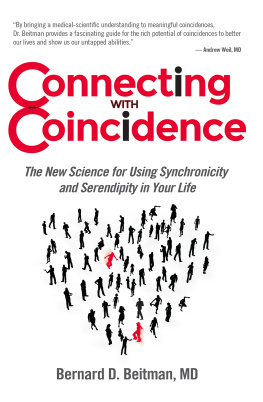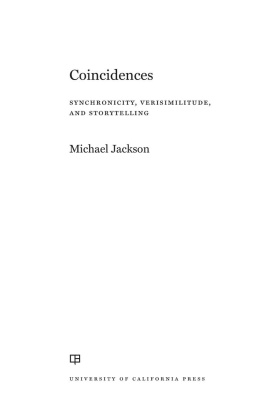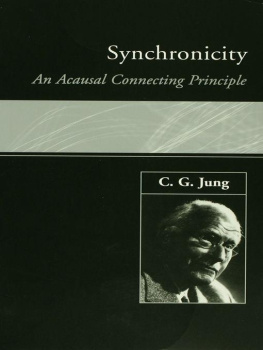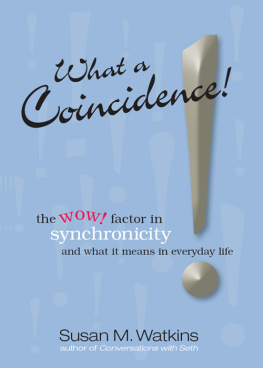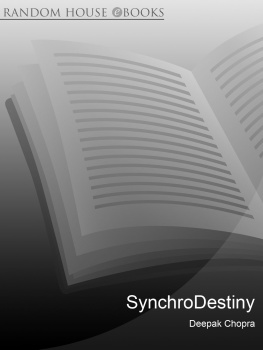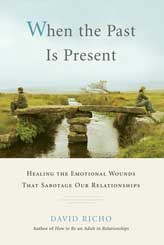Connecting
WITH
Coincidence
The New Science for Using Synchronicity
and Serendipity in Your Life
Bernard D. Beitman, MD
Health Communications, Inc.
Deerfield Beach, Florida
www.hcibooks.com
Cataloging in Publication Data is available through the Library of Congress
2016 Bernard D. Beitman
ISBN-13: 978-07573-1884-9 (Paperback)
ISBN-10: 07573-1884-3 (Paperback)
ISBN-13: 978-07573-1885-6 (ePub)
ISBN-10: 07573-1885-1 (ePub)
All rights reserved. Printed in the United States of America. No part of this publication may be reproduced, stored in a retrieval system, or transmitted in any form or by any means, electronic, mechanical, photocopying, recording, or otherwise, without the written permission of the publisher.
HCI, its logos, and marks are trademarks of Health Communications, Inc.
Publisher: Health Communications, Inc.
3201 S.W. 15th Street
Deerfield Beach, FL 334428190
Cover design by Dane Wesolko
Interior design and formatting by Lawna Patterson Oldfield
ePub created by Dawn Von Strolley Grove
Coincidences alert us
to the mysterious hiding
in plain sight.
Contents
At some point in our lives, all of us have experienced a fleeting moment when a weird coincidence made us smile and wonder. It could have been a song that came on the radio just as it went through your mind or a phone call from a long-lost friend the very day you thought of this person. Or, it could appear as it did for Saundrain black and white letters. Saundra was enjoying Chinese food at her fathers house and texted her sister to let her know that one of their favorite movies, The Wizard of Oz , was on television. Her sister texted back that she remembered watching the movie with their mother, who was now deceased. Mom would always fix popcorn... she typed as she fondly remembered their treasured times together.
While Saundra was reading her sisters text message, she grabbed a fortune cookie and opened it. Much to her delight, her fortune greeted her with the word popcorn .
Something special had just happened to Saundra, and when she texted her sister to tell her, they both felt the presence and comfort of their mother.
Ive been deeply interested in coincidences like this most of my lifetrying to make sense of them, to understand how best to use them, and how best to explain them to skeptics and believers alike.
I had experienced coincidences many times before, but none was more startling than what happened at 11:00 PM on February 26, 1973, when I was thirty-one years old. Suddenly, I found myself bent over the kitchen sink in an old Victorian house on Hayes Street in the Fillmore District of San Francisco. I was choking on something caught in my throat. I couldnt cough it up. I hadnt eaten anything. I didnt know what was in my throat. Id never choked for this long before. Finally, after fifteen minutes or so, I could swallow and breathe normally.
The next day, my birthday, my brother called to tell me that our father had died in Wilmington, Delaware, at 2:00 AM Eastern Standard Time. He was three thousand miles and three time zones away; 2:00 AM in Wilmington was 11:00 PM in California. My father had bled into his throat and choked on his own blood at about the same time I was uncontrollably choking. He died on February 27, my birthday.
Was this just a coincidence? No. The timing was too perfect. The experience was too visceral. I loved my father, but I had no idea that our connection could transcend time and space in this way. I began to wonder if other people had had similar experiences.
A man riding a train back to his home in Zurich, Switzerland, was suddenly overtaken by a frightening vision of someone drowning. Upon arriving home, he discovered that his grandson had almost drowned in the lake by his house around the time of the terrifying vision.
The man in this story was psychiatrist Carl Jung, who invented the word synchronicity for a wide spectrum of weird coincidences. He personally experienced many strange events, but his writings focused more on theoretical speculation. Known as the preeminent theoretician of coincidence, he developed the synchronicity theory using complex ideas from quantum physics and ancient philosophies, along with his own concepts of the collective unconscious and archetypes. He also clearly documented that meaningful coincidences have been recognized throughout human history in many different cultures. Ive explored much the same forest as Jung but followed a different path.
I grew up in Wilmington, Delaware, the headquarters of the DuPont Company, where chemistry was king. During some school assemblies, we watched movies depicting the history of this onetime gunpowder company, which started on the banks of the Brandywine River that runs through Wilmington. I liked chemistry and majored in chemistry at Swarthmore College. If Id continued on in this major, I wouldve been faced with a choice of becoming either a chemist or a chemical engineer. The chemist comes up with new ideas and molecules. The chemical engineer figures out how to use them. I chose the practical path, but not in that discipline. I became a psychiatrist, a profession in which chemicals are often used to help people.
As one whose profession revolves around the life of the mind, I also began to notice the weird coincidences in my life, as well as those in the lives of my patients. My fascination with the subject eventually led me to conduct research on coincidence at the University of Missouri-Columbia, the results of which appeared in two issues of the journal Psychiatric Annals , for which I was the editor. Now the engineer in me is using the results of that research to put coincidence to practical use. I see myself as an engineer for Jungs theoretical ideas.
As demonstrated by my research at the University of Missouri-Columbia, at least a third of the general population frequently notices weird coincidences. Friends, colleagues, patients, acquaintances, and strangers standing in line at a coffee shopmany people seem to be talking about, if not experiencing, coincidences these days. What a coincidence! What are the chances of that happening? Let me tell you about this coincidence. In our modern technological culture, there are even smartphone apps to help you track your coincidences.
But what do people mean by coincidence?
For some people, coincidences represent random chance at work. To these rationalists, the universe runs like a clock, and the laws of probability describe how the Grand Machine runs. They are just or mere or only coincidences. Others believe that meaningful coincidences are the work of a personal God who is guiding and nurturing them. In between God and probability lies a broad spectrum of theories. The emerging field of coincidence studies, a field Im helping to develop, proposes closer connections between mind and environment than are currently accepted in psychiatry and psychology.
Our perceptions of coincidence emerge from swirls of information in our minds juxtaposed with swirls of events in our surroundings. Like two dials being spun by separate hands, the active mind and a pattern of events briefly coincide, causing the mind to note an odd correspondence. The match is often surprising because it seems improbable. But coincidence is more than the unlikely juxtaposition of similar eventsthe two events must also be meaningfully connected, and the meaning is personal and intricately linked to the person involved.
Many books offer compilations of amazing coincidence stories, and there is no shortage of books advocating specific theories. This book is different. Ive tried to pull apart the coincidence reports from many different sources to see how and why they couldve happened the way they did. In the process of examining these stories, Ive come to discover the essential features that make coincidences happen, including the personality characteristics and situational factors that serve to increase their frequency. These characteristics and factors have proven to be so consistent that I realized we actually doand canmake our own coincidences.

